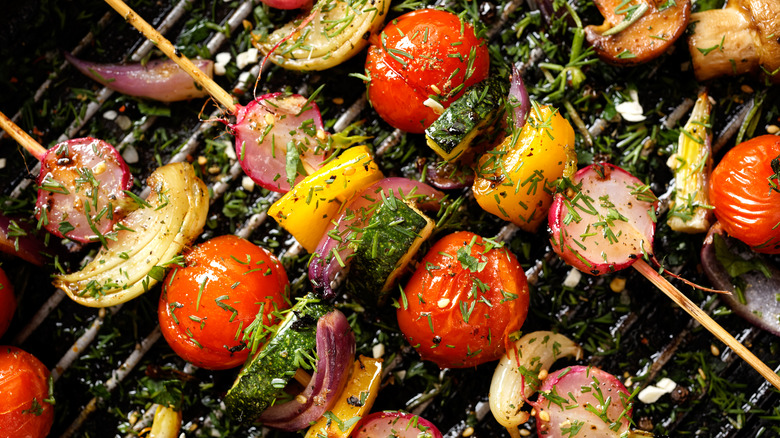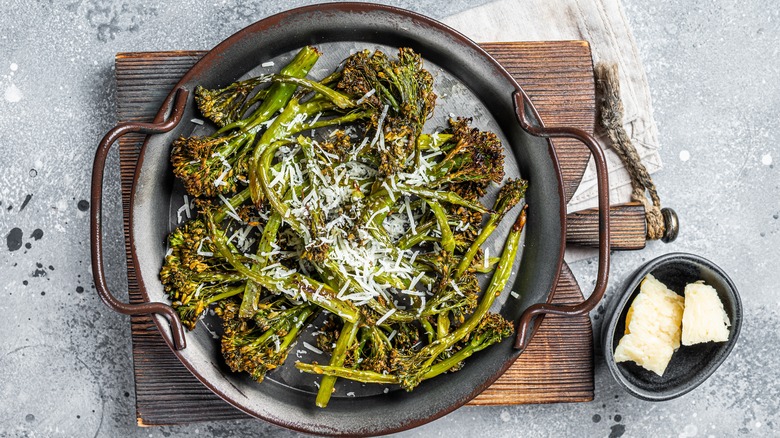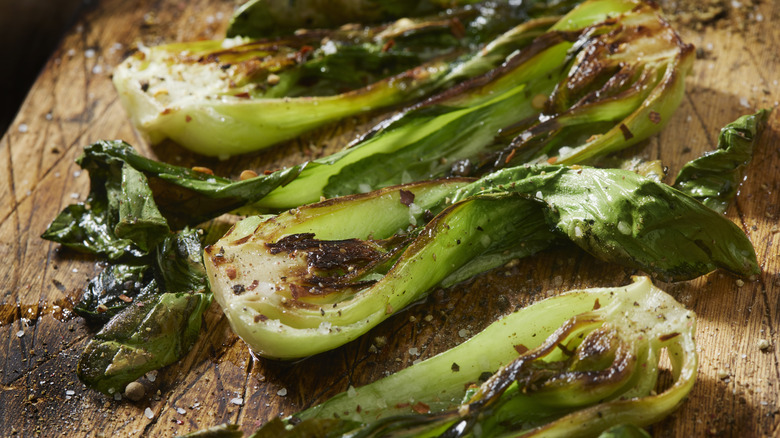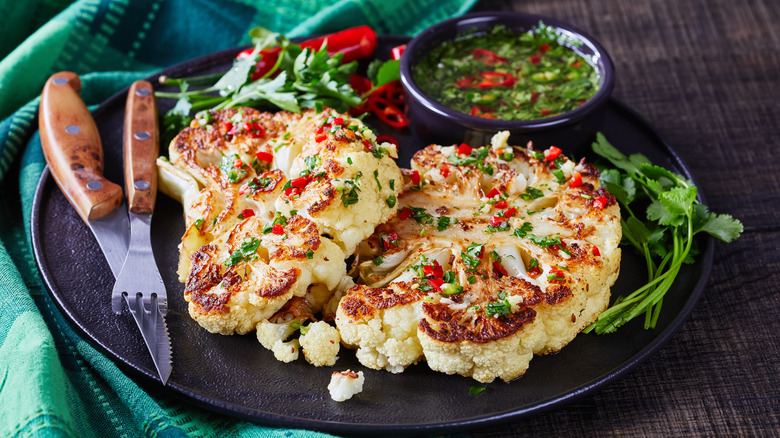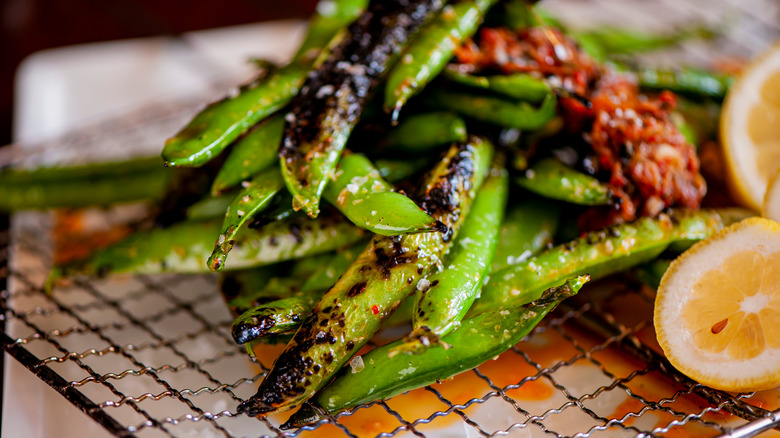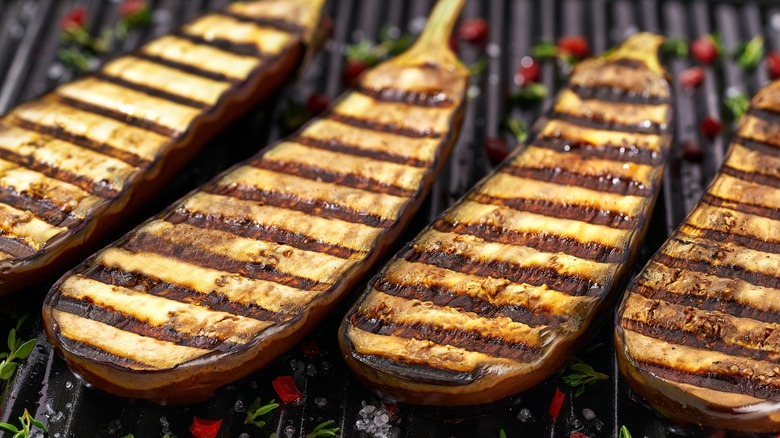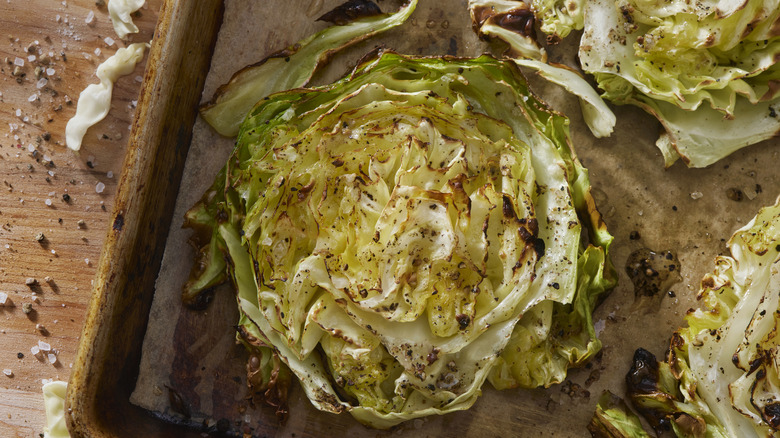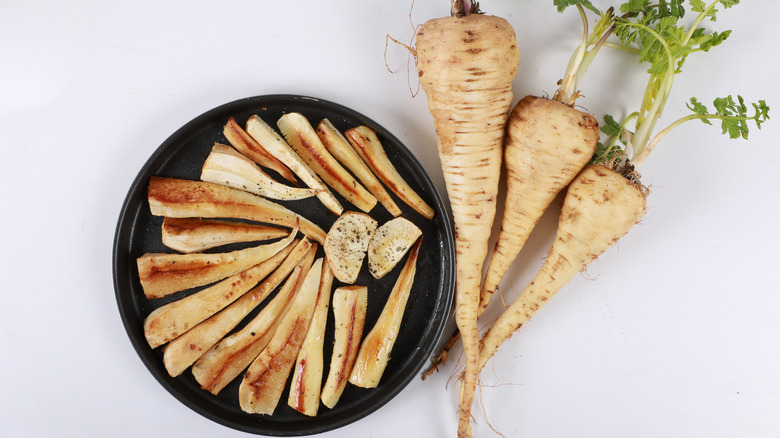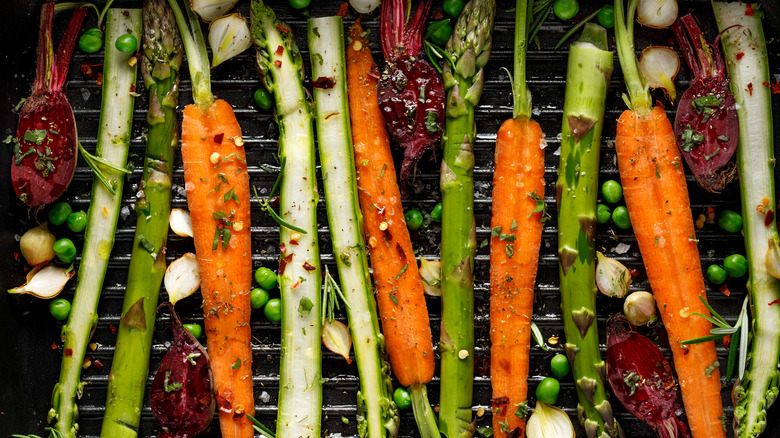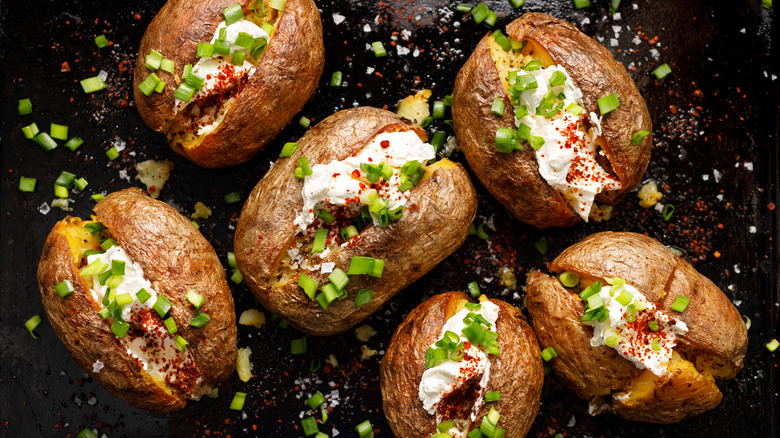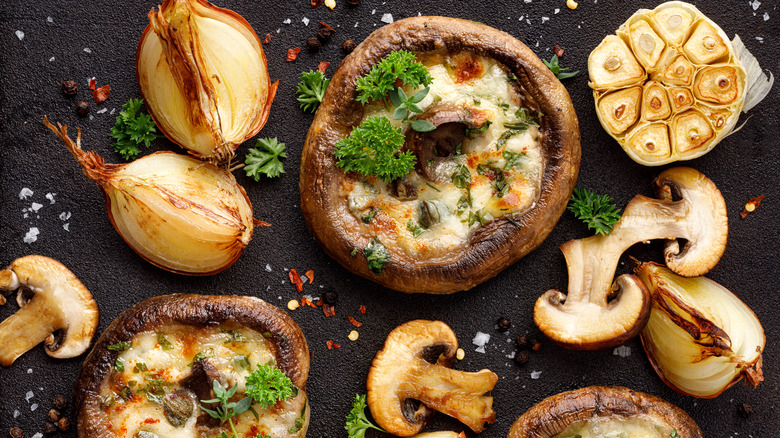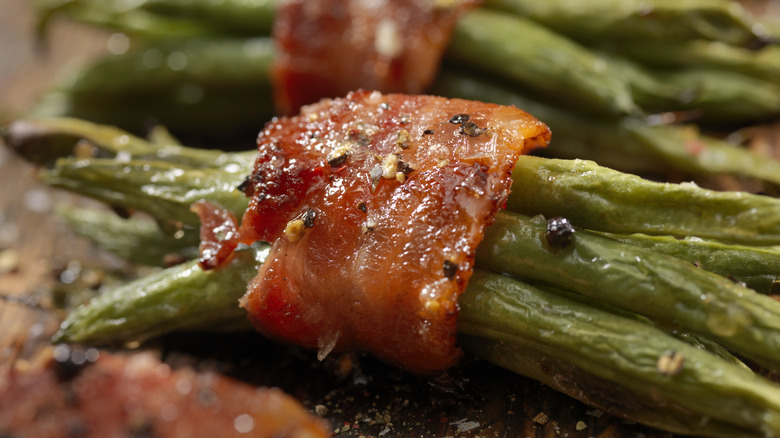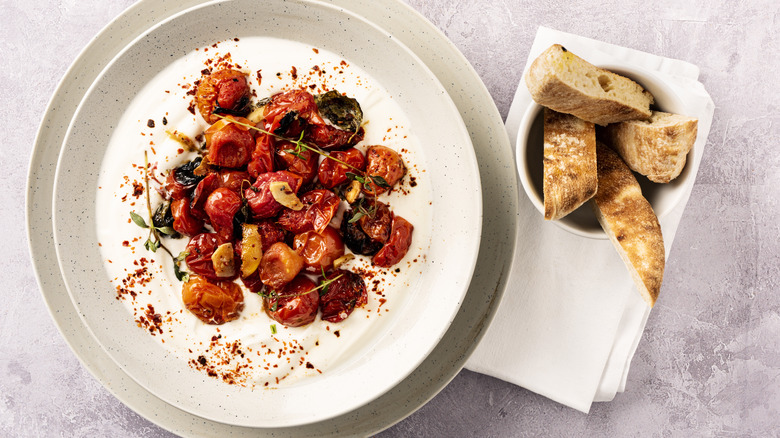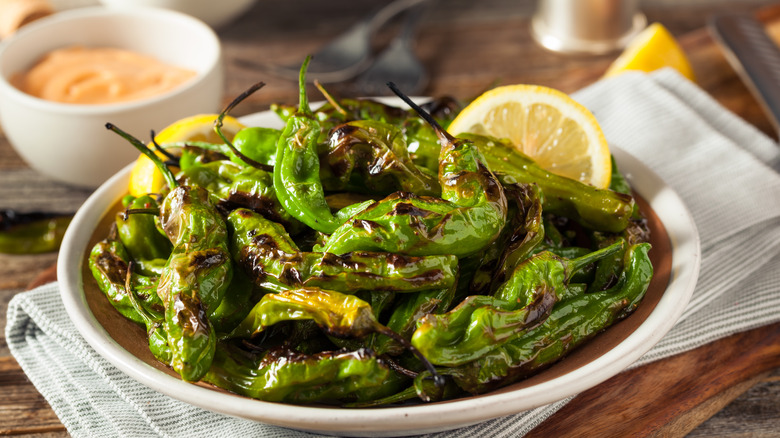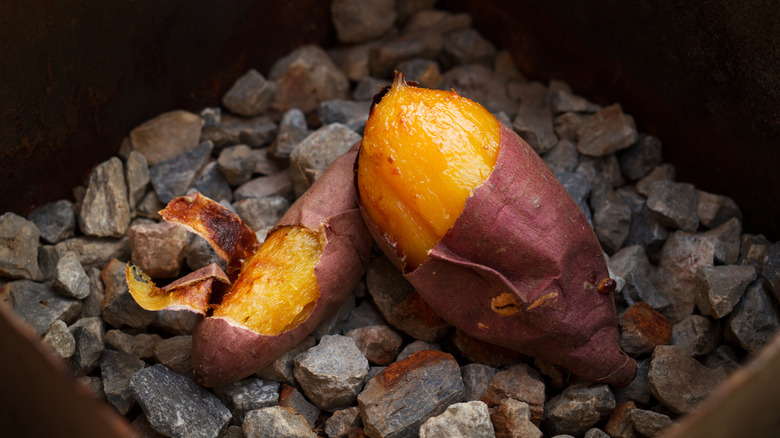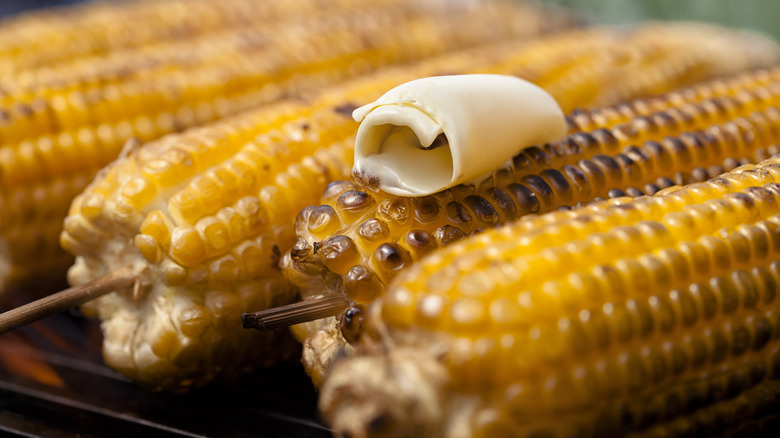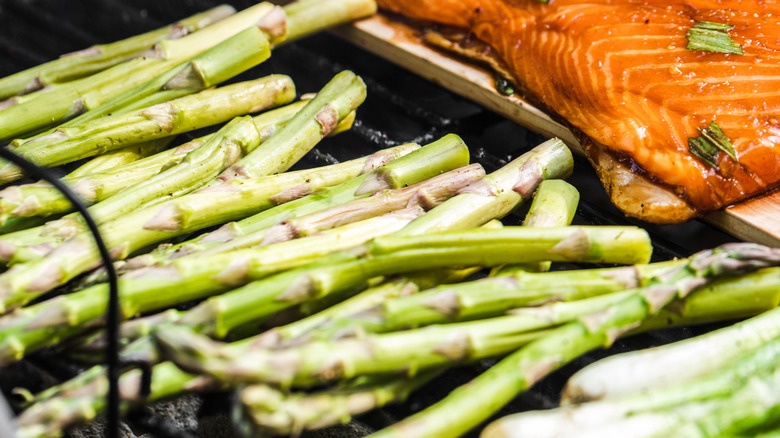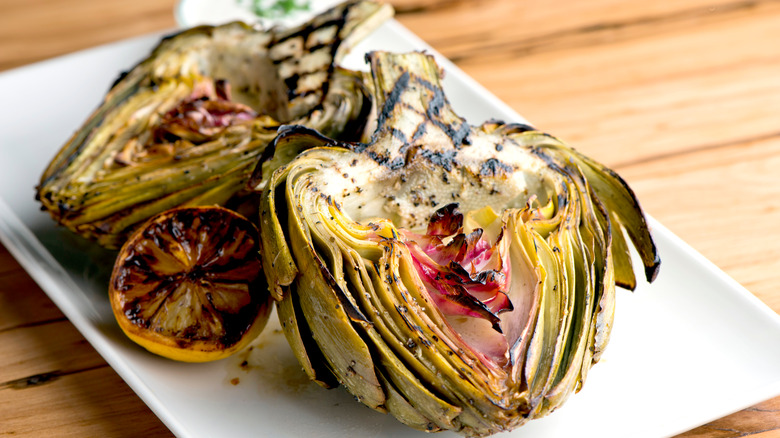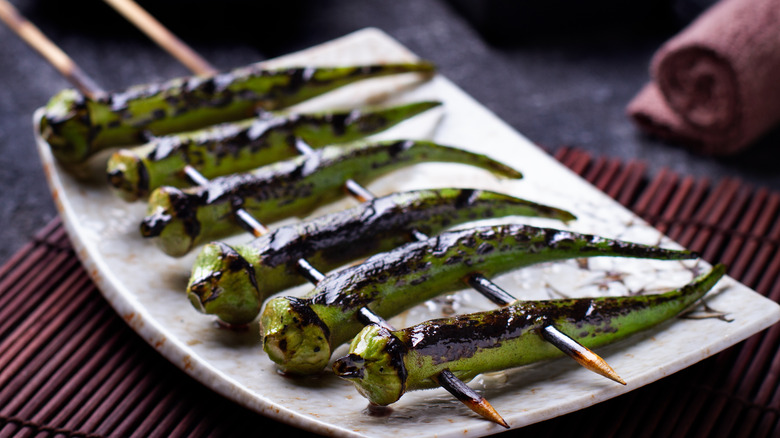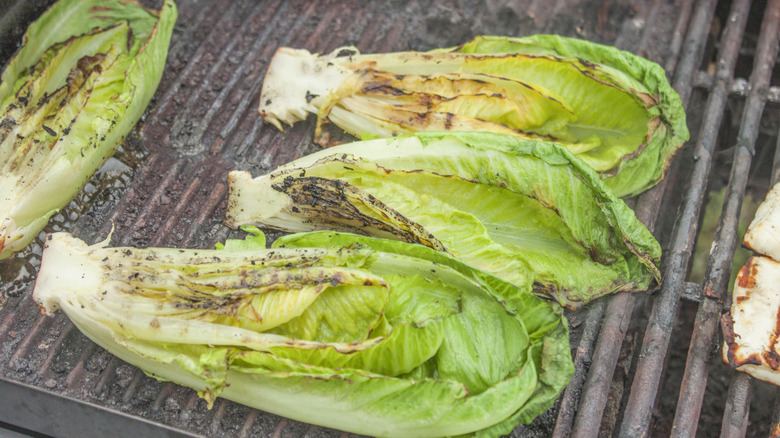19 Best Veggies That Can Stand Up To The Char Of Your Grill
We may receive a commission on purchases made from links.
Whether you're trying to take down your red meat consumption for health reasons or just need some new grilling alternatives, we've got you covered. Knowing how to grill vegetables is one part of the process. An excellent tip before firing up the grill is to season or marinate your veg just like you would fish or meat. Sweet or spicy sauces and dry rubs can make all the difference. And knowing what vegetables are best for the grill is important, especially considering how charring can elevate the flavors of certain veggies.
Consider that vegetables, like meat, have unique characteristics that impact the preparation for certain types versus others. Everything from the shape, size, or water density of the vegetables could affect whether they should be skewered together (best for thinner or more delicate veg like edamame or green peas). Or placed over direct or indirect heat based on water content (veggies with higher water density like lettuce can handle direct heat while drier veg like carrots does better with indirect).
Also: Avoid using a grill brush to clean your grill before or after grilling. According to the Centers for Disease Control and Prevention, the spiky bristles can fall off the brush and end up in your food. Instead, clean your grill with alternatives. A white vinegar spray on the grill scrubbed with half an onion is an all-natural method that does the trick safely.
Broccolini
Although broccolini could be considered a close cousin to broccoli due to the collection of florets on their head, the flavor difference between broccoli and broccolini — strong and rustic versus moderate and grassy respectively — makes broccolini more favorable than broccoli for grilling.
This Chinese and American crossbreed was actually conceived in Japan and needs a little extra awareness since the florets char easily on a grill if sitting too long. The best way to mitigate this is to spread the coals unevenly on your grill, with the meatier stems above more direct heat from the coals than the floret so that the crown doesn't char to a crisp before your broccolini is done.
Try this broccolini with grilled lemon recipe for a well-balanced hit of citrus and smoke courtesy of the Aleppo chili. Roughly 1 pound of broccolini with three lemons for grilling will get you started. Other ingredients include one small shallot, 1 tablespoon fresh lemon juice, 1 tablespoon unsalted butter, ¼ cup pine nuts with 1 tablespoon parsley, another 1 tablespoon chopped chives, and of course a light dusting of ground Aleppo chili to taste.
Baby bok choy
Another vegetable great for the grill with a surprising lineage is baby bok choy. Bok choy is actually one of 14 types of cabbage varieties and is a great brain food that also helps fight cancer.
Here are some tips you need when cooking with bok choy. Cut it in half and give it a good wash to get out the granules of dirt left behind, while leaving the vegetable relatively intact. Also with regard to seasoning, it's important to season bok choy in a marinade of your choice — maybe a quick and easy tamari and sesame oil seasoning — before placing it on the grill with the flat side facing the heat. Like broccolini, you'll need to keep an eye on the leafy crowns of bok choy to ensure they don't singe over direct heat.
Here's another recipe that relies on Asian-inflected ingredients. Just 1 1/2 pounds of baby bok choy (around six heads of bok choy) slathered with 3 tablespoons of unsalted butter and white or yellow miso paste brings out the best in this cruciferous Chinese superfood.
Cauliflower
According to Healthline, just a single cup of cauliflower is packed with vitamins C, K, and B6, along with several other nutrients that fight diabetic conditions, cancers, and heart conditions. We also know it as an extra tasty vegetable when roasted, whether sliced into cauliflower steaks or done whole. There are pros and cons to both depending on your preference.
When it comes to the best way to grill cauliflower, some grill masters would say roasting a whole head of cauliflower is the only way to go. There's no risk of cutting yourself while negotiating a knife for cutting, no way for the cruciferous powerhouse to slip through the cracks in your grill, and due to its higher grilling time, allows for the whole vegetable to pull in more barbeque smoke and flavor. Grilled cauliflower with tahini and sumac is an incredible seasoning combo for taking this route.
On the other hand, a cauliflower steak, prepped in a casserole dish two hours before touching the grill, can be a whole other thing of beauty. Just make sure the steaks are thick enough not to fall through your grill.
Edamame
According to Everyday Health, Edamame is a bean originally grown in China and coveted in Asia, gaining some popularity in the United States in the 1970s. High in amino acids, the edamame bean contains the highest amount of protein per serving, with a ½ cup of edamame accounting for the total daily recommended protein intake for the average 2,000-calorie diet.
When it comes to edamame, unlike sugar snap peas, eating them raw with the shells on is probably not the best way to go due to their shell casing's bitter and deceptively chewy exterior. The beans, however, are great raw, cooked, or mashed, and will also stand up surprisingly well to the heat of your grill.
Lay frozen edamame beans (in their shells) on a thin layer of foil and season with your favorite flavor combinations. Like the smokiness of chili and cayenne pepper, basic salt and pepper — any of that works just fine. Toss over your grill periodically to get a good char on both sides of your edamame, and in under five minutes, serve with some olive oil and the juice of half a lemon.
Eggplants
Although "Eggplant" may have been given its name by British colonizers in India according to WebMD, the nightshade vegetable has been around for centuries. It was introduced to Europe in the 7th century and since then, whether called aubergine, brinjal, or eggplant, remains a meaty, versatile grilling companion. High in vitamins A, C, and K, and loaded with a whopping 229 milligrams of potassium per serving, there's no reason to fear this often intimidating vegetable.
There are a few tips you need when cooking with eggplant. There are several varieties of eggplant on the market — some smaller but more flavorful, others bigger with more muted flavors but added versatility if seasoned well — but the grill can make proper use of most of them. Make sure to slice your eggplant into round or lengthwise cuts, salt liberally, and leave out over a paper towel for up to 30 minutes to remove excess moisture. For grilling purposes, slash hatch marks into the eggplant to give it that grill-marked aesthetic Instagram craves, or place them whole over a charcoal grill to create the charcoal-smoked baba ganoush of your dreams. The Maillard Reaction, a chemical reaction in food caused by high heat that causes amino acids to merge with each other, leads to browning and an enhanced flavor. For lengthwise or round cuts, try this grilled eggplant recipe.
Cabbage
Cabbage is one of the most underrated veggies on this list because of its funky odor — and when it's overcooked it has a mushy reputation. Here's why you should start grilling cabbage, according to superstar Chef Michael Symon. "They play very nicely to the grill," Symon says, advising the leafy head be chopped into quarters for a perfect char over a hot grill. "They grill a lot of the hardier greens in Europe, but cabbage works great because it holds up to it." In the interview, Symon also suggests leaving one side of the grill without direct heat from coals so smaller sized wedges with quicker cooking times have somewhere to rest without burning.
Another "Top Chef," Harold Dieterle's grilled cabbage with chili lime vinaigrette makes excellent use of this method with a simple yet mind blowing salad. A heady mix of grill smoke with a perfect balance of sour and sweet is an American version of an Asian slaw that will change any cabbage naysayer's mind.
Parsnips
Though the root vegetables are similar in appearance and both wonderful for grilling, carrots and parsnips are quite different. The difference between parsnips and carrots lies within their texture and flavor. Parsnips lean more toward the savory side than carrots, although parsnips were once used as a sweetener in Europe — and they are also best eaten cooked rather than raw. This hardier nature makes them great candidates for hot grills.
Chef Yotam Ottolenghi's confit and grilled parsnips with herbs and vinegar take parsnips on a journey after pickling the parsnips in a bowl with salt, the vinegary tang of apple cider vinegar, and the heat from two chopped red chilies. He then places them in an olive oil flavor bath (450 milliliters of oil) and infuses them with the garlicky goodness of 10 whole cloves of garlic and more salt before popping the roasting pan in the oven under foil at a preheated 350 degrees Fahrenheit. After an hour they're basically cooked. Place the remaining oil aside, and fire up the grill. Grill both sides until grill marks appear and the parsnips have a char to them. Pour 60 milliliters of the leftover garlic-infused oil into a bowl with the crushed clove, 4 tablespoons of coriander, 3 tablespoons of parsley, 1 teaspoon of ground allspice, salt and pepper to taste.
Carrots
Carrots are sweeter than their root vegetable counterpart parsnips. Of course, just because they start out sweet, doesn't mean their density and natural taste don't lend themselves to some proper grilling. For best results on the grill, however, it's important you don't skip this step for ultra tender grilled carrots. According to the advice offered by chef Yotam Ottolenghi on MasterClass, you should steam your carrots for a maximum of 10 minutes, and place them in a simple marinade of olive oil, citrus, spice, and sugar before placing them on a blistering grill. This ensures your carrots don't burn or lose any flavor before they're actually cooked — once you see char marks, they're done.
As simple as this recipe is, you can also get more complex and fancy. Past chef at NYC's Empellon Cocina (now executive chef and owner of midtown Manhattan's Mischa), Alex Stupak demonstrated the complexities with Empellon Cocina's roasted carrots. This 24-ingredient roasted carrot salad leverages mole poblano, greek yogurt, fried sesame seeds, and Middle Eastern flavors to great effect. Want to keep it under two dozen ingredients? Make this bbq with carrots with ranch, a Southern style offering incorporating dry herbs and buttermilk as a marinade before basting the carrots with your favorite barbecue sauce.
Baked potatoes
We all know the pleasures of a beautiful baked potato, preferably with a dollop of butter, sour cream — maybe even bacon! Most of that experience probably comes in the form of oven-baked potatoes. This summer, why stop at just baking your potato? The grill is perfectly suited to elevating a humble baked potato into something pleasantly unexpected.
Like the other root vegetables on this list, it's a very good idea to start the process just as you would with any baked potato — boil it in a pot of salted water for about 10 minutes or until fork tender. Once that's done, let it rest and cool down outside the pot while you preheat your grill. To make the world's finest grilled potato salad with feta and dill, slice the potato in two, drizzle with olive oil, and place the halves flat-side down onto your grill. Since you've already parboiled the potato, it shouldn't take very long to cook — 12 to 15 minutes will do the trick. Transfer your potato into a large bowl with 1/4 pound feta cheese, the zest and juice of one lemon, 1/2 cup dill, a diced shallot, and good quality EVO (extra virgin olive oil). Salt and pepper to taste. Grilled scalloped potatoes also scream summer, and is another grilled potato recipe to try.
Portobello mushrooms
If you were wondering how to grill the perfect mushroom, we've got you covered. Portobello mushrooms are big and meaty enough to stand in for steak, and similarly handle any seasoning you throw at it. Portobello mushrooms are the best for the grill, and you will want to use the method of piling all your direct charcoal heat in the middle of the grill to provide heat variance. That way you can transfer mushrooms that cook faster than the others somewhere with less direct heat so they don't char to a crisp.
First, wash your mushrooms thoroughly to get off the dirt, and anything else lingering on your shrooms. Carefully pat them dry with a paper towel. Marinate your portobello in something as simple as olive oil, one or two cloves of chopped garlic, and chili flakes. Again, treat your vegetable with as much care as you would red meat, and season liberally with salt and pepper to taste before laying your portobello cap-side up slightly off to the side of your hot coals. Four minutes on each side and voila! You can eat them just like this when they're done or dice and spice up your portobello in a meatless Mexican grilled portobello mushroom taco.
Green beans
Due to their size and delicate nature, grilled green beans cook quickly — two minutes on each side max — but offer fantastic flavor. Even with a light char, the insides of the vegetable become tender while the outer shell hangs on to barbecue essence. Smoke and seasoning in the form of sea salt, lemon, and pepper, are all you need to make a snack out of them. You can also serve over a rich almond cream puree consisting of a 1/4 cup almond milk, 1 ¼ ounces almond oil, 1 cup roasted almonds, 2 cloves roasted garlic, the juice from a 1/4 cucumber, and 2 tablespoons white wine vinegar.
For something more substantial and spicy, try grilled green beans with harissa, made by tossing your grilled green beans with 1 tablespoon red wine vinegar, 1 tablespoon olive oil, 1 fiery teaspoon of harissa, and 1/2 teaspoon salt. Either way, you'll need to keep an eye on these because they char fast — but you definitely want that char.
Tomatoes
It's possible tomatoes are not the first thing you think of when grilling. Most of us who have any experience trying to grill tomatoes have ended up with a soggy, limp mess. Knowing the biggest mistakes you need to avoid when preparing tomatoes for the grill can help you perfect the art of tomato grilling. The type of tomato always matters and will affect how well your tomato turns out. For grilling purposes, larger tomatoes (heirloom or beefsteak come to mind) are your best bet for the grill. Make sure you slice them with a serrated knife since your tomatoes will get a cleaner cut without difficulty. As for seasoning, tomatoes love herbs like basil, thyme, and rosemary, so an olive oil marinade including any or all of these herbs will make for a fabulous grilled tomato feast.
Although smaller tomatoes, like cherry tomatoes, aren't necessarily great for grilling on their own, skewered together they are quite tasty. As with this grilled halloumi and tomato skewers recipe, you won't need to worry about your tiny tomatoes falling through your grates to be burned to a crisp.
Shishito peppers
Shishito are slender little peppers originally from Japan, with a milder heat than, say, jalapeño peppers. Grilling them so they get a slight char is actually the best way to cook them since their thin exteriors absorb the grill's smoke and your seasoning very well. When it comes to seasoning, not much more is needed than peppers with lemon and sea salt. This works best in a cast iron pan as opposed to directly on the grill, since it ensures relatively even cooking without the threat of any shishito literally falling through the cracks. Of course, if you don't have a decent pan, you can always skewer your peppers together to avoid the issue.
Still, if you're looking for something a little more interesting, lean into the Japanese roots of shishito peppers with Shichimi Togarashi. Shichimi Togarashi is a Japanese condiment consisting of seven spices — hemp or poppy seeds, sesame seeds, chili pepper, ground ginger, sansho pepper, mandarin or yuzu orange zest, and seaweed. When skewered together with some sea salt, this makes for an explosion Asian influenced flavors.
Sweet potatoes
One big mistake people tend to make with sweet potatoes is starting out with bad produce. Even before approaching your grill, ensure you are using a quality product. Sweet potatoes that are off are typically soft to the touch, not quite the right color, and sprouting all over their surface. These are not great to eat, off your grill or otherwise. As with a piece of meat or fish, freshness always matters.
This vegetable's versatility lends it to grilled sweet potato salad, cut lengthwise into ½-inch spears, covered in olive oil, and initially seasoned with kosher salt and black pepper. This hardy root vegetable handles charring quite well — and the Middle Eastern-Asian fusion of turmeric, yogurt, Thai basil, and ginger makes this potato salad unlike any you've ever tasted.
Although this doesn't necessarily happen on the grill, you can still upgrade your grill game with sweet potato burger buns. It makes a nice platform for your burger, and a drizzle of olive oil before placement on your grill definitely makes these burgers grill adjacent.
Corn on the cob
Corn on the cob is a beloved barbecue staple for many and for good reason. There's nothing like the taste of grilled corn slathered in creamy butter, and the explosion of salt, sweet, and smoke in your mouth. One super simple way to upgrade your grilled corn is to add an extra layer of seasoning immediately after grilling, which should take eight to 12 minutes. Make sure all sides are turned and evenly charred. Dipping your grilled corn into a 1 liter pitcher of salty brine immediately after it's cooked can elevate the aforementioned explosion of flavors in each kernel.
But salt isn't the only way to inject more umami into your food. Experiment with the tastes and textures of different cultures like garam masala-infused ghee, cardamom, and ginger in Indian grilled corn. Transform your grilled kernels into grilled corn soup, a dollop of creamy yogurt with a hint of minty freshness takes this dish beyond typical bbq fare.
Asparagus
Asparagus is a quintessential summer vegetable, and it's amazing on the grill! The heat and smoke tend to bring out all the best in the spear-shaped barbecue favorite. Here's why you should blanche asparagus before grilling it. Blanching is the process of pre-cooking a more dense vegetable in a pot of boiling salt water before submerging it in ice water to pause the cooking process. This ensures that your asparagus cooks faster so that by the time the exterior is charred, its interior is also soft and evenly cooked.
Another benefit of the blanching process is that it allows you to opt for thick asparagus, which are better suited to stand up to the char of your grill than thinner asparagus. Pair the herbaceous smokiness of grilled asparagus with the salty creaminess of feta like in this grilled asparagus and feta quiche, or combine the smokiness of Spanish Idiazábal cheese with barbecue smoke in grilled asparagus with Idiazábal.
Artichokes
Artichokes can be an intimidating vegetable to work with on or off the grill. Maybe it's because of the natural layers of the veggie that need to be peeled away in order to work with it that make it seem daunting. A few tips you need when cooking artichokes are to use artichokes that are fresh and intact with a squeakiness to them — keep them refrigerated for up to two weeks until you're ready to grill. To cut an artichoke, use a sharp knife and trim the exterior leaves until you get to the softer, edible leaves toward their core. Cut off the sharp ends of the remaining leaves, pull off the stem's skin, and use a teaspoon to pull out the tough core. Just remember, you shouldn't eat the whole artichoke.
Finally, you always want to get your artichokes into a bowl of lemon water to keep the fresh look of the artichoke. The acid in the lemon will stop artichokes from going brown after cutting.
Once you've mastered prepping artichoke, you can get down to the business of grilling it. Try grilled artichokes with pine nut purée or a hot and smoky version of the same dish.
Okra
Okra is an internationally known, pepper-shaped vegetable, with edible seed pods. Cultivated in mainly Southern states after being brought over from West Africa during the Transatlantic slave trade, the vegetable is a staple in southern soups and stews like gumbo.
Skewer your okra before placing it on a hot grill — like in this blackened okra with red rice — and take your grilled okra in any number of directions based on seasoning preferences.
Romaine lettuce
While better known as a base for salads, romaine lettuce can also take the flame from a grill like a champ. However, there is a prep step you can't forget when grilling romaine – which aside from the obvious washing of your veg — is integral to your grilling success. Slice off any wilted bits since they will burn and threaten to degrade the flavor of your romaine — you want the lettuce caramelized, lightly charred and smoky, not ashen and bitter.
A grilled romaine salad is a thing of beauty, and matching the saltiness of anchovies and peppery pecorino with grill smoke and char raises the bar on salads. You should eat grilled romaine right after it's cooked because it will wilt and lose some of its texture immediately. A great plan would be to have all the other components of your salad ready to go before grilling your romaine lettuce so that once it's done, you can assemble your ingredients and eat everything while it's at its best.

